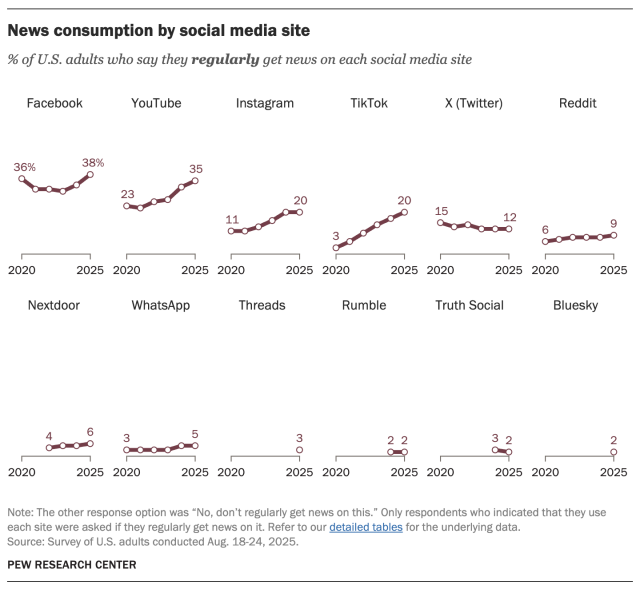☀️ Happy Thursday! The Briefing is your guide to the world of news and information. Sign up here!
In today’s email:
- Featured story: Jimmy Kimmel addresses free speech and free press in return to ABC
- New from Pew Research Center: Platforms Americans use to get news, including social media and podcasts
- In other news: New Pentagon policy restricting journalists draws pushback
- Looking ahead: Trump expected to sign TikTok deal
- Chart of the week: Facebook and YouTube remain top social media sites where Americans get news
🔥 Featured story
Jimmy Kimmel returned to late-night television and drew big ratings on Tuesday after ABC suspended him for his comments about the aftermath of Charlie Kirk’s killing. In his opening monologue, Kimmel defended free speech and the freedom of the press after Federal Communications Commission chair Brendan Carr had suggested there would be “additional work for the FCC” if media companies did not “take action” against Kimmel. Sinclair and Nexstar, which together own ABC affiliates that reach about 23% of U.S. households, continue to keep Kimmel’s show off their stations.
Seven-in-ten Americans are at least somewhat concerned about potential restrictions on press freedom in the U.S., according to a Pew Research Center survey conducted in late February and early March. Partisan views on press freedom have flipped since 2024. Under the Trump administration, a majority of Democrats and Democratic-leaning independents (60%) are extremely or very concerned about restrictions on press freedoms – about double the share of Republicans and GOP leaners (28%). In 2024, during the Biden administration, Republicans were more likely than Democrats to express concern about press freedoms (47% vs. 38%).
About one-third of Americans say speech and press are completely free in the U.S. Partisan views on these questions have also shifted since last year.
🚨 New from Pew Research Center
We released new data today updating trends on the platforms where U.S. adults get their news. Our fact sheets examine the use of traditional media like television, radio and print publications, plus a range of digital pathways. Follow the links below:
- An analysis of news consumption on various platforms
- News consumption on social media sites, including X, YouTube and Instagram
- A new fact sheet looking at who listens to podcasts and gets news there
And read our updated analysis highlighting the rapid increase in the share of Americans who get news on TikTok.
📌 In other news
- New Pentagon policy requiring pledge from credentialed journalists not to report on unauthorized material draws pushback from news orgs
- U.S. judge tosses Trump’s $15 billion defamation lawsuit against The New York Times and Penguin Random House
- The Dallas Morning News completes sale to Hearst, rejecting bid by Alden Global Capital
- Former Washington Post columnist files grievance after being fired over her social media posts about Charlie Kirk
- Microsoft in talks to develop AI marketplace for publishers
- MSNBC makes a deal with Sky News to share newsgathering services
- New Jersey PBS will shut down in 2026 after funding cuts to public broadcasting
📅 Looking ahead
President Donald Trump is set to sign an executive order on Thursday that would facilitate the sale of TikTok’s U.S. operations from China-based company ByteDance to a group of American investors – potentially including Larry Ellison, Michael Dell and the Murdoch family. The deal would comply with a law passed in 2024 that sought to ban TikTok in the U.S. if ByteDance did not divest its ownership.
This comes amid a sharp increase in the share of U.S. adults who get news on TikTok. According to a new Pew Research Center survey, one-in-five U.S. adults now regularly get news there, up from just 3% in 2020. Among adults under 30, 43% say they regularly get news on TikTok, more than four times the share who said this five years ago (9%). No other social media platform we’ve studied has experienced faster growth in news consumption over that time.
📊 Chart of the week
This week’s chart comes from our updated fact sheet about how Americans get news on social media. Facebook and YouTube outpace all other social media sites as places where Americans regularly get news: 38% of U.S. adults say they regularly get news on Facebook, and 35% say the same about YouTube.
Smaller shares of Americans regularly get news on Instagram (20%), TikTok (20%) or X, formerly Twitter (12%). Fewer say they get news on Reddit (9%), Nextdoor (6%), WhatsApp (5%), Threads (3%), Rumble (2%), Truth Social (2%) and Bluesky (2%).

👋 That’s all for this week.
The Briefing is compiled by Pew Research Center staff, including Naomi Forman-Katz, Jacob Liedke, Christopher St. Aubin, Luxuan Wang, Emily Tomasik and Joanne Haner. It is edited by Michael Lipka and copy edited by Anna Jackson.
Do you like this newsletter? Email us at info@pewresearch.org or fill out this two-question survey to tell us what you think.